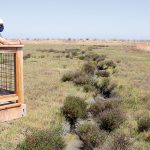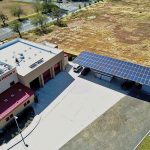
The Bay Area Regional Reliability partnership has discussed expanding Los Vaqueros Reservoir, shown here in July 2012. Photo by George Miller.
It feels like California’s 2011-2016 drought, our worst on record, had barely ended when the next one began. This is our second dry year in a row and, according to the state Department of Water Resources, the past winter tied for the third-driest on record. “Right now, California is dealing with a pretty severe and deepening drought,” said UCLA climate scientist Daniel Swain. He calls this our second major drought within a decade and, if you’re like me, you’re wondering if we’ve done anything since the last one to help keep water flowing from our taps. The answer is yes.
Early during that record-breaking dry stretch, eight Bay Area water agencies that collectively serve six million people formed a partnership — called Bay Area Regional Reliability (BARR) — to bolster regional drought preparation. “Unlike in some places, Bay Area agencies have developed ties including relationships and infrastructure,” explained BARR co-project manager Bradley Ledesma, an East Bay Municipal Utility District (EBMUD) civil engineer. “When we hit record drought, it caused agencies to think about the bigger picture: how can we work together to increase resilience for the Bay Area?”
This collaboration will be even more critical in the future. California has naturally swung between deluge and drought for millennia. But climate change will intensify these swings, making droughts even more frequent and even more severe.
Funded partly by a $400,000 U.S. Bureau of Reclamation grant, the BARR team identified ways to boost the reliability of the Bay Area’s water supply. One idea is a shared desalination plant that treats brackish water from the Sacramento-San Joaquin River Delta. Another possibility is transferring water from EBMUD to Marin County via a pipeline across the Richmond-San Rafael Bridge or along the bottom of the San Francisco Bay. Most of the options are in the conceptual phase. “Large projects can take decades,” Ledesma said. But one is well underway: the expansion of Los Vaqueros Reservoir, which is owned by the Contra Costa Water District and sits in hills near Altamont Pass, overlooking the city of Livermore.
Los Vaqueros Reservoir has already been expanded once. Built in 1998, the reservoir originally stored 100,000 acre-feet, enough to supply about 200,000 households for a year. The first expansion raised the dam 34 feet, increasing storage to 160,000 acre-feet. The proposed second expansion would raise the dam another 55 feet, increasing storage to 275,000 acre-feet. Currently, the Contra Costa Water District uses all the water stored in Los Vaqueros Reservoir. But the BARR team thinks the upcoming expansion could also benefit other water agencies, including Valley Water in Santa Clara County. “This is a test case — can one agency store water in another agency’s facility?” Ledesma said.
Valley Water could easily get water into Los Vaqueros Reservoir. This is because the reservoir ties into a federal water delivery system called the Central Valley Project (CVP), and Valley Water has rights to CVP water. The problem is that the reservoir doesn’t tie into Valley Water’s own delivery system. “There’s no way to get water out of Los Vaqueros Reservoir and into the Valley Water system,” Ledesma explained. The expansion project would solve this problem by building a new eight-mile pipeline that connects the reservoir with an aqueduct that transports water to the South Bay.
Benefits of the Los Vaqueros expansion to Valley Water are clear. The agency would gain 30,000 acre-feet of storage, or 10 percent of its annual water use. That could help the agency take advantage of winters when water is plentiful. “If there’s a really wet year, we could grab that supply and put it in Los Vaqueros,” said Samantha Greene, Valley Water’s lead on the expansion project.
This extra water could come in handy if the Delta, which supplies about 40 percent of the agency’s water, was too salty. Water in the Delta could be undrinkable if rising tides pushed sea water further inland, or if a levee break pulled sea water further in. “If a levee goes, it could be out for a year or two,” Greene said. “The expansion project could buy us a little time — when people want water, they usually want it now.”
That said, Valley Water has a long list of other options for building such redundancy into Santa Clara County’s water supply and is weighing the benefits of the Los Vaqueros Reservoir expansion against its cost. And the project’s price tag is eye-popping: The Contra Costa Water District puts it at $895 million. “Building a dam is very expensive,” Greene noted. An estimated $223 million would come from federal sources including the Water Infrastructure Improvements for the Nation Act that Congress passed in 2016; $470 million from state sources including Proposition 1, the water bond that California voters passed in 2014; and $202 million in local sources. The expansion project is scheduled to begin the design and construction phase in 2022, and is scheduled for completion in 2029.
Valley Water is one of several Bay Area water agencies considering partnering with the Contra Costa Water District on — and shouldering a share of the local cost of — the Los Vaqueros Reservoir expansion. “The question is whether it is the best option for the buck,” Greene said. “Is it the best use of ratepayer money?” Other possible partners on the expansion include the Alameda County Water District, EBMUD, the San Francisco Public Utilities Commission, and the Zone 7 Water Agency, which serves the cities of Dublin, Livermore, and Pleasanton.
These agencies are also all BARR members and so, whatever their decisions on this particular project, are committed to building regional drought resilience. Moreover, the other options identified by the BARR team remain on the table for if and when they are needed in California’s hotter, drier future. “We all experience drought in different ways,” Ledesma said, referencing the fact that each agency has its own mix of water sources, from Sierra Nevada snow melt to regional rainfall to local groundwater recharge. “We want to make it easier for Bay Area water agencies to share water.”
Robin Meadows covers water for the Monitor.

